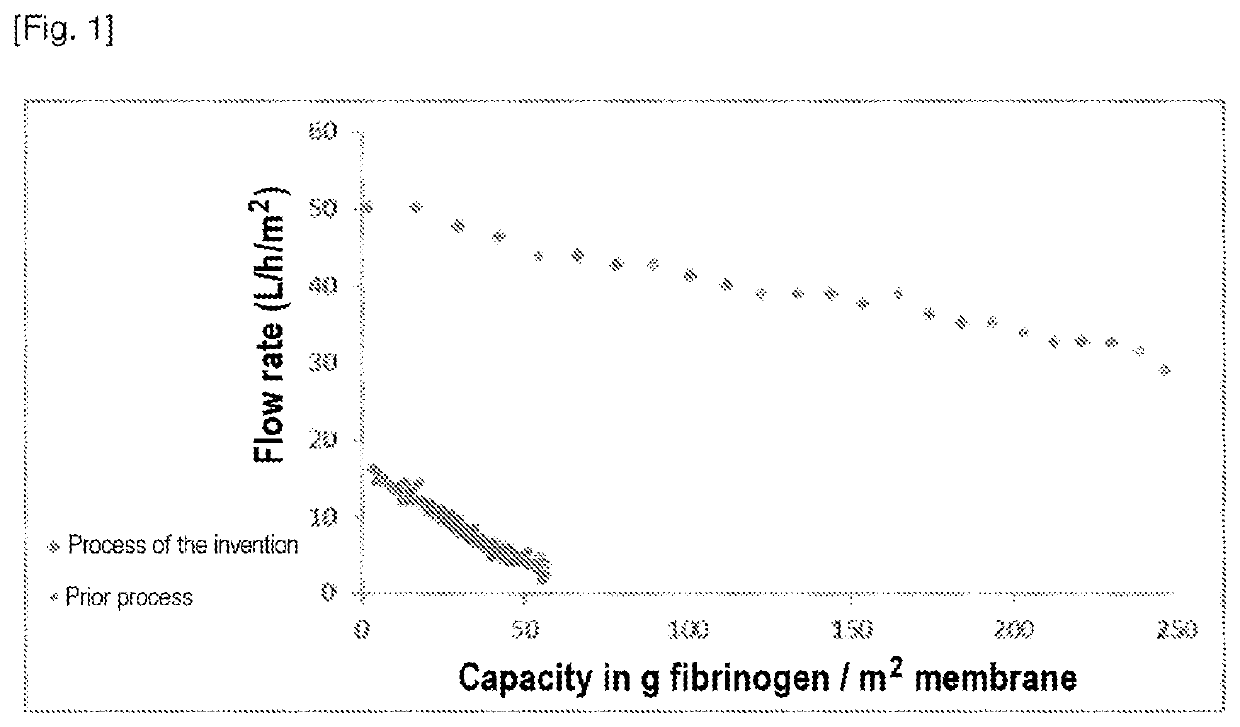Method for Filtering Fibrinogen
- Summary
- Abstract
- Description
- Claims
- Application Information
AI Technical Summary
Benefits of technology
Problems solved by technology
Method used
Image
Examples
example 1
Evaluation of Fibrinogen Filtration on a 20 nm Symmetrical Filter in Accordance with the Invention
[0179]The composition comprising prepurified fibrinogen is obtained according to the method described in EP1739093.
[0180]I—Objectives
To evaluate the filterability of a composition comprising fibrinogen on a symmetrical nanofiltration filter with a pore size of about 20 nm.
[0181]II—Operating Parameters
Filtration sequence[0182]0.2 - 0.1 pm polyethersulfone (PES) filter[0183]20 nm symmetrical Pegasus SV4 filter from Pall Life Sciences, surface area 0.00096 m2 (Pegasus VF SV4, 10MCFSV4, surface area 9.6 cm2).[0184]The solution containing fibrinogen is concentrated to 3 g / L and is more than 90% pure.
TABLE 1Steps / Parameters20 nm filter evaluationRaw materialFibrinogen chromatography eluate obtained according to EP1739093eluted in buffer comprising 200 mM arginineFiltration sequence0.2-0.1 μm PES20 nm 0.00096 m2Total protein g / L2.7Pressure mbar2110 ± 10 (on 20 nm filter)
[0185]III—Results
[0186]...
example 2
Evaluation of Fibrinogen Filtration on Symmetrical 20 nm Pall DV 20 Filter in Accordance with the Invention
[0193]The composition comprising prepurified fibrinogen is obtained according to the method described in the application EP1739093.
[0194]I—Objectives
To evaluate the filterability of a composition comprising fibrinogen on a symmetrical nanofiltration filter with a pore size of about 20 nm.
[0195]II—Operating Parameters
Filtration sequence[0196]0.2-0.1 μm polyethersulfone (PES) filter[0197]20 nm symmetrical ULTIPOR VF DV20 filter from Pall Life Sciences, surface area 0.00106 m2.
[0198]The solution containing fibrinogen is concentrated to 3.1 g / L and more than 90% pure.
TABLE 3Steps / Parameters20 nm filter evaluationRaw materialFibrinogen chromatography eluate obtained according to EP1739093eluted in buffer comprising 200 mM arginineFiltration 0.2-0.1 μm PESsequence20 nm 0.00106 m2Total protein g / L3.1Pressure mbar2027 ± 7 (on 0.2-0.1 μm filter)2025 ± 39 (on 20 nm filter)
[0199]III—Resul...
example 3
Evaluation of Fibrinogen Filtration on 20 nm Symmetrical Filter in Accordance with the Invention with 20-50 nm Prefiltration
[0205]The composition comprising prepurified fibrinogen is obtained according to the method described in the application EP1739093.
[0206]I—Objectives
To evaluate the filterability of a composition comprising fibrinogen on a symmetrical nanofiltration filter with a pore size of about 20 nm.
[0207]II—Operating Parameters
Filtration sequence[0208]0.2-0.1 μm polyethersulfone (PES) filter[0209]35 nm filter (Planova 35N from Asahi)[0210]20 nm symmetrical Pegasus SV4 filter from Pall Life Sciences, surface area 0.00096 m2 (Pegasus VF SV4, 10MCFSV4, surface area 9.6 cm2).
[0211]The solution containing fibrinogen is concentrated to 3 g / L and is more than 90% pure.
TABLE 5Steps / Parameters20 nm filter evaluationRaw Fibrinogen chromatography eluate materialobtained according to EP1739093eluted in buffer comprising 200 mM arginineFiltration 0.2-0.1 μm PESsequence35 nm 0.01 m2 + ...
PUM
| Property | Measurement | Unit |
|---|---|---|
| Weight | aaaaa | aaaaa |
| Length | aaaaa | aaaaa |
| Length | aaaaa | aaaaa |
Abstract
Description
Claims
Application Information
 Login to View More
Login to View More - R&D
- Intellectual Property
- Life Sciences
- Materials
- Tech Scout
- Unparalleled Data Quality
- Higher Quality Content
- 60% Fewer Hallucinations
Browse by: Latest US Patents, China's latest patents, Technical Efficacy Thesaurus, Application Domain, Technology Topic, Popular Technical Reports.
© 2025 PatSnap. All rights reserved.Legal|Privacy policy|Modern Slavery Act Transparency Statement|Sitemap|About US| Contact US: help@patsnap.com

